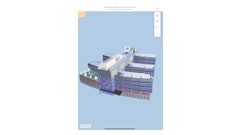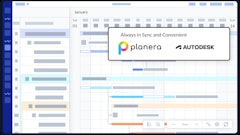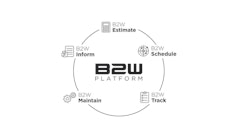
The construction industry has a reputation for being a slow adopter of new technology. In fact – and not to put too fine a point on this, but – one anonymous company highlighted in the JB Knowledge 2021 ConTech Report was quoted saying:
“We use technology only when we have no other choice.”
Yikes! Fortunately, this isn’t representative of the entire industry, but the point stands that technology remains a delicate subject, and for good reason: email inboxes are a cluttered mess, file transfers can be a hassle, access to project data is unreliable after a project’s end, data security is no laughing matter, and – perhaps most importantly of all – adopting technology is a huge change management challenge that we need to surmount in order to keep delivering bigger, better projects.
The good news is that this is becoming less and less representative of the construction industry. Traditionally, most discussions of our challenges revolved around questions of productivity, efficiency, value engineering, and quality; but today, the successful adoption of Information Technology (IT), Construction Information Management, and Building Information Modeling (BIM) are what lead the conversation.
And the best way to manage each is with a project management platform.
For general contractors especially, the foreseeable future will focus on the digitization of processes and workflows, which will propel firms to increase their use of collaboration and management software. But like all tools, these are dependent on the expertise of its users; and expertise does not exist in independent silos, but in the interconnected approach of the entire organization. Gone are the days when each stakeholder in a project could operate in their own little corner, each delivering their work to a centralized overseer to make sense of it all: successful architect, engineer and general contractor firms (including all disciplines) are today adopting a new approach that connects one another and every stakeholder, leading to true collaboration.
Here is the recipe for success when working with stakeholders on projects, the Four Cs:
- Communication
- Cooperation
- Coordination
- Collaboration
Wait, don’t all these terms mean the same thing? Well, not quite – let’s examine how each element builds on the previous one and ties it to the success of your projects, and how they can be enhanced with the right project management platform.
 Dialogue between stakeholders over tasks or issues in individual communication channels is always the first rung on the 4C ladder.@Yuttana Studio - adobe.stock.com
Dialogue between stakeholders over tasks or issues in individual communication channels is always the first rung on the 4C ladder.@Yuttana Studio - adobe.stock.com
1. Communication
Typical Channels: Email and communication management platforms
When Mastered: Avoid costly misunderstandings and delays.
Dialogue between stakeholders over tasks or issues in individual communication channels is always the first rung on the 4C ladder. This tends to be informal, typically without a global governing strategy for working together, but every new interaction is based on a specific need to be addressed. This can include on-demand information sharing, or questions on resources. As such, power remains within each organization.
An organizational relationship based on communication is useful when AEC firms have minimal scope of work on a project, allowing them to be informed of developments or issues without having a stake in the responsibility to resolve them. This is very common for architectural design firms, specialized design firms (i.e. highway design), specialized contractors (i.e. fire protection contractor), owner consultants (i.e. estimating consultant), or approving bodies (i.e. cities or municipalities.)
2. Cooperation
Typical Channels: Email, messaging apps, file sharing apps
When Mastered: Reduce time spent on conflict resolution and rework
Cooperation involves firms working together more regularly for recurring tasks or issues. Like Communication, this level still has very little overall strategy or plan for sharing expertise, but there is a stronger need for AEC firms to keep each other apprised of developments and issues as they occur.
Examples can include the sharing of tactical information, adapting cultural or work processes to accommodate the actions and goals of other firms, and establishing commitments. All the while, accountability remains within each organization.
An organizational relationship based on cooperation is useful when AEC firms have a basic scope of work on a project, which allows them to be involved with issues and to take part in their resolution without a major commitment or responsibility. This is common for specialized design firms (i.e. landscape designer), specialized contractors (i.e. sustainability consultant), owner or approving bodies (i.e. cities or municipalities), and is often done through file sharing apps like Dropbox or Sharepoint.
3. Coordination
Typical Channels: Email, messaging apps, file sharing apps, BIM coordination platforms, project and information management platforms, common data environments
When Mastered: Decrease costs associated with mismanagement and inefficiency by 20%
Coordination involves a more common workflow between organizations, often with an informal or unofficial strategy for sharing expertise or experience. There is much more alignment in terms of policies, programs and resources here, and greater trust between organizations.
Typical examples of coordination can include structured communication flows, formalized project-based information sharing, or joint policies, programs, and aligned resources. It might also include the use of common data environments to centralize project data storage and access.
An organizational relationship based on coordination is useful when AEC firms have a significant scope of work on a project and are expected to be directly involved and invested in resolving issues and following developments by having a direct stake, commitment and responsibility. This is common for design-build and design-bid-build projects such as design firms (i.e. MEP consultant), general contractors, specialized contractors (i.e. plumbing contractor) or owner’s consultant (i.e. BIM consultant).
When coordinating to manage a project, many contractor firms will find it useful to have a coordination platform to handle submittals and RFIs; a common platform between stakeholders means that information will be accessible by everyone in one place. Some coordination platforms can also link to external file sharing apps, so that the project record includes which files were shared, by whom, and when.
Without such a platform, many firms rely on expansive, messy spreadsheets, and can waste precious time looking for documentation lost in Outlook inboxes.
4. Collaboration
Typical Channels: Email, messaging apps, file sharing apps, BIM coordination platforms, project and information management platforms, mobile applications for project management, common data environments
When Mastered: Reduce project durations by up to 30% and cost savings of 25% or more, by leveraging pooled resources and expertise.
Collaboration is the highest level of interaction in the workflow context between AEC organizations. It involves firms establishing interdependent and intertwined systems, where all experience, knowledge and resources are shared, and a high level of trust is in place. Firms usually have a history of working together before achieving this level of interaction.
Examples of collaboration can include tactical information sharing, polled or collective resource exchanges, and power-sharing between organizations.
An organizational relationship based on collaboration is useful when AEC firms have a significant scope of work on a project, the project is very large (in scale and budget) and when the project is very long (in time). This is common for design firms (i.e. structural designer), general contractor, specialized contractor (i.e. electrical contractor) and owner. This is also common for integrated project delivery, and public-private partnerships.
In an industry where most projects will involve more than one software program, it is more important than ever to break down the silos. All stakeholders benefit from being connected.
Complex projects involve design authoring, analytics, construction management, model checking, field, and visualization. And with an array of disciplines involved, each using their preferred software, it is an understatement to say that getting to true collaboration can be challenging, but that’s where BIM comes into play. BIM is more than just 3D modeling and true BIM is all about collaboration; and while software cannot drive the BIM process alone, finding the right tool for collaboration solves many issues before they become issues.
The 4Cs are a roadmap for how to approach communal work, while IT and project information management are the avenues by which this work is coordinated.
Project management platforms are useful at every stage in the 4C ladder, as once the platform is adopted, each becomes easier. For example, you can rely on email to get messages across to your stakeholders, but you can also send a note on a specific action item inside the platform. Or, you can send emails like you always have, but it’s much easier to search through them by topic, attachment, or keyword than it is by simply using Outlook.
So, with the right coordination platform, you’ll never get lost at C!
























